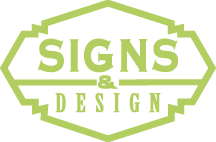In the graphics world, there are two main file types— raster and vector. When customers come to us with their signage needs we always request vector graphics. Here’s why.
One example of a raster graphic is a photograph. Raster images are made from tons of tiny squares (pixels) that have individual color codes to create a photo. The more pixels per inch, the higher quality and resolution a photo will be.
While it’s better to have more PPI (pixels per inch), it also makes file sizes ginormous. Think about it. If you have an 8’ x 4’ banner being created at 300 PPI, that’s 1,382,400 individual pieces of information. This makes it difficult to send large files, and it takes forever to open them. Another downside to raster graphics is that once you’ve got them saved at a certain size and resolution (8’x 4’ at 300 PPI), if you try to drastically resize the graphics it will affect the image’s resolution.
On the flipside, vector images are created from sets of lines and curves. These have mathematical values so that vector art can be resized without affecting image resolution. Vector graphics are typically fonts and logos. Because vector graphics are sets of mathematical values, their file sizes are much smaller. Thus making these files easier to send.

The major issue encountered with vector graphics is compatibility. Vector art can be saved as a PDF so that it can be opened on a computer without design software, but to edit a vector file you need programs like Adobe Illustrator.
A more frequent issue we encounter at our shop is someone resaving a raster image in a vector file format. This does not mean the file is suddenly a vector image capable of being resized without issue. Stay tuned for an upcoming post expanding on why this won’t work.
If you need to have any kind of signage made and do not have vector graphics, we staff two graphic designers that are able to re-create most graphics in vector form. There is a fee for this service, and it’s based upon the time it takes to redo the art.
As detailed in this article, raster and vector graphics have their respective uses. There are pros and cons to both file formats, but vector is usually preferred when it comes to creating signage.
Accepted File Formats
Vector: EPS, AI, PDF
Raster: JPG, PNG, TIF, PSD
